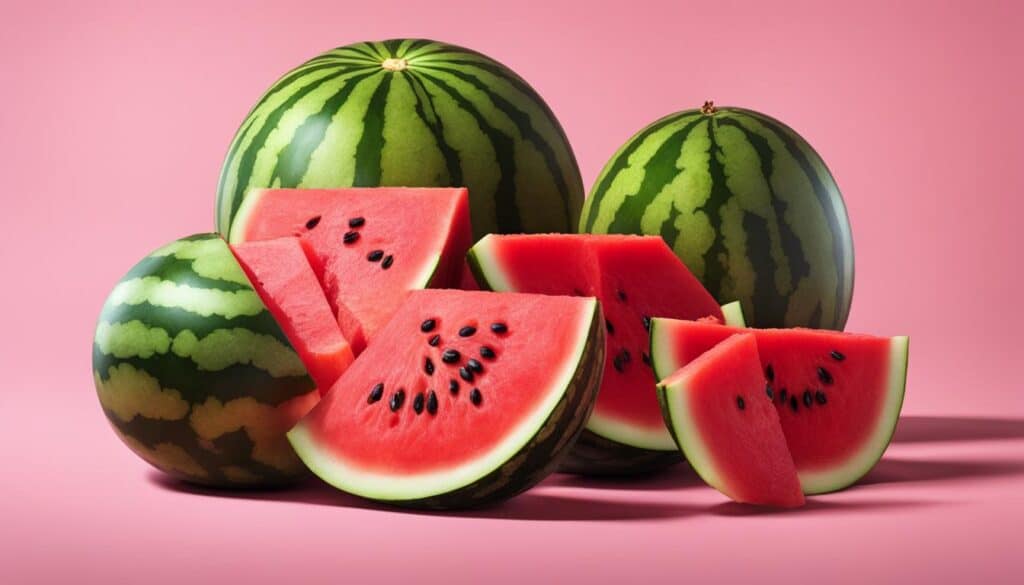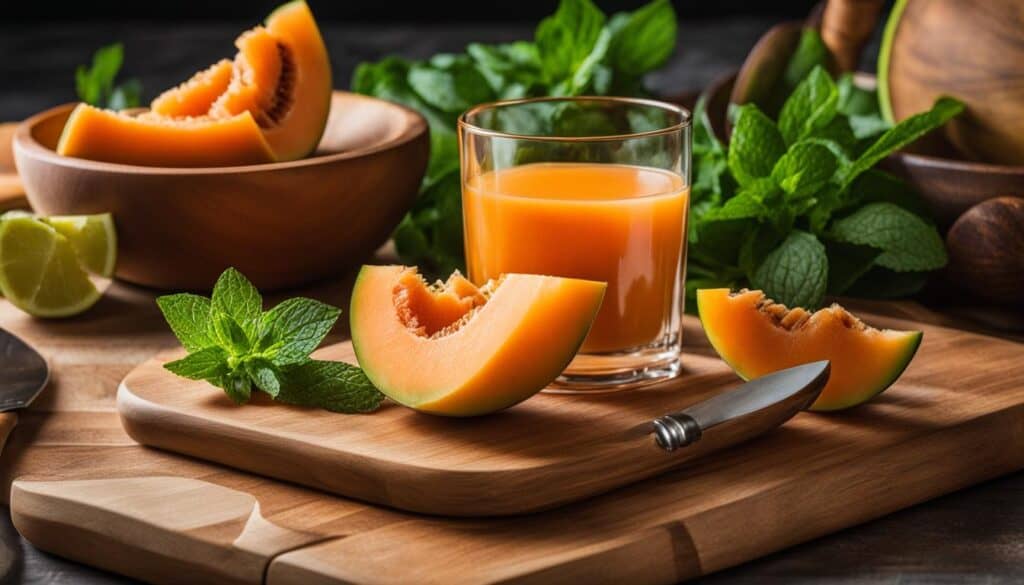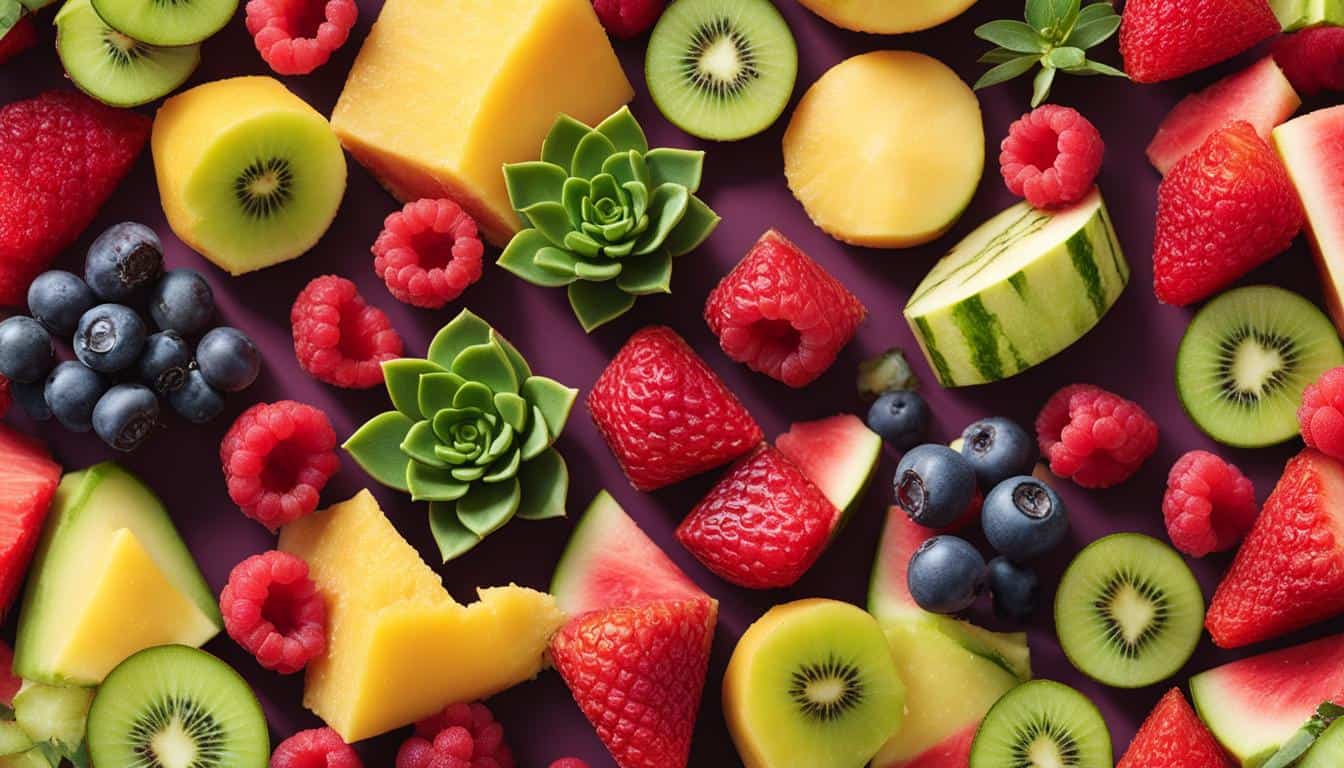Greetings, fruit enthusiasts! Today, I want to take you on a delightful journey through the world of fruits, with a special focus on the beloved cantaloupe. While cantaloupe is undoubtedly a tasty treat, did you know that there are other fruits out there that share similar qualities? In this article, we will explore a variety of fruits that are like cantaloupe in taste, texture, and culinary versatility.
So, if you’re curious about fruit alternatives or substitutes to cantaloupe, stay tuned because we’re about to dive into a juicy adventure!
Key Takeaways:
- There are fruits that share similar qualities and flavors with cantaloupe.
- Watermelon and honeydew melon are refreshing alternatives to cantaloupe.
- Muskmelon, casaba melon, mango, papaya, and apricot are also great substitutes for cantaloupe.
- These fruits can be used in various culinary creations, including salads, smoothies, and desserts.
- Exploring fruits like cantaloupe opens up a world of delicious possibilities.
Overview of Watermelon and Honeydew Melon
When it comes to juicy, refreshing fruits, watermelon and honeydew melon are two popular choices that share some similarities with cantaloupe. Let’s take a closer look at these delicious fruits and explore their unique characteristics.
Watermelon: This large, oblong fruit is known for its vibrant red flesh and sweet taste. With its high water content, watermelon is incredibly hydrating and perfect for hot summer days. The texture of watermelon is crisp and crunchy, providing a satisfying bite. It comes in various varieties, such as seedless, yellow, and icebox, each offering a slightly different flavor profile.
Honeydew Melon: With its smooth, pale green rind and sweet, juicy flesh, honeydew melon offers a delightful taste experience. It has a mild and delicate flavor with hints of pear and cucumber. The texture of honeydew melon is smooth and slightly firm, making it a refreshing addition to fruit salads or desserts. Like watermelon, honeydew melon comes in different varieties, such as orange honeydew and golden honeydew, each with its own unique flavor and characteristics.
Varieties of Watermelon and Honeydew Melon
| Watermelon Varieties | Description | Appearance | Taste | Texture |
|---|---|---|---|---|
| Seedless | A popular variety with small, edible seeds | Bright red flesh | Sweet with a hint of tanginess | Crisp and juicy |
| Yellow | Known for its yellow flesh and sweeter taste | Yellow flesh | Extra sweet | Crisp and juicy |
| Icebox | A smaller variety, perfect for individual servings | Red or yellow flesh | Sweet and refreshing | Crisp and juicy |
What sets watermelon and honeydew melon apart from cantaloupe is their distinctive flavors and textures. Watermelon offers a sweeter, tangier taste with a crisp and crunchy texture, while honeydew melon delights with its mild, refreshing flavor and smooth, slightly firm texture. Both fruits are perfect for enjoying on their own, adding to fruit salads, or using in various culinary creations.
Nutritional Comparison of Watermelon, Honeydew Melon, and Cantaloupe

When it comes to comparing the nutritional profiles of watermelon, honeydew melon, and cantaloupe, these fruits offer a range of essential vitamins and minerals while being relatively low in calories. Let’s take a closer look at their nutritional values:
Nutrient Comparison
| Fruit | Calories | Carbohydrates (g) | Fat (g) | Protein (g) | Vitamin C (mg) | Vitamin A (IU) | Potassium (mg) |
|---|---|---|---|---|---|---|---|
| Watermelon | 30 | 8 | 0 | 1 | 9 | 569 | 112 |
| Honeydew Melon | 61 | 15 | 0 | 1 | 18 | 39 | 388 |
| Cantaloupe | 53 | 13 | 0 | 1 | 58 | 3382 | 417 |
As seen in the table above, watermelon has the lowest calorie content of the three fruits, followed by cantaloupe and honeydew melon. Cantaloupe stands out with its high vitamin C and vitamin A content, while watermelon offers a good source of potassium. Honeydew melon provides a moderate amount of potassium and vitamin C. All three fruits are low in fat and protein, making them a healthy choice for those looking to incorporate nutritious, low-calorie options into their diet.
It’s important to note that these nutritional values may vary slightly depending on the specific variety and ripeness of the fruits.
Growing and Harvesting Cantaloupe
If you’re interested in growing your own cantaloupe, it’s important to know the proper techniques for planting, growing, and harvesting. Cantaloupe plants thrive in warm climates and require well-drained soil and full sun. They can be grown from seeds or transplants, with proper care and maintenance throughout the growing season.
When planting cantaloupe, make sure to space the plants about 2 to 3 feet apart to allow for sufficient airflow and prevent overcrowding. This will help reduce the risk of disease and ensure that each plant has enough space to grow and produce fruit.
Cantaloupes are typically ready to be harvested when they are fully ripe. You can determine ripeness by looking for a sweet aroma, deep color, and slightly soft skin. The stem nearest to the fruit should easily detach when gently pulled. Remember to harvest cantaloupes carefully to avoid damaging the fruit.
| Season | Planting | Harvesting | Ripeness Indicator |
|---|---|---|---|
| Spring | After the danger of frost has passed | Mid to late summer | Sweet aroma, deep color, and slightly soft skin |
| Fall | 8 to 10 weeks before the first expected frost | Early to mid-fall | Sweet aroma, deep color, and slightly soft skin |
Cantaloupe Growing Tips:
- Choose a sunny spot in your garden with well-drained soil.
- Prepare the soil by removing any weeds and adding compost or organic matter.
- Sow the seeds or transplant the seedlings according to the recommended spacing.
- Water the plants regularly, ensuring that the soil remains evenly moist.
- Provide support for the vines by using trellises or stakes.
- Monitor the plants for pests and diseases, and take appropriate action if needed.
- Harvest the cantaloupes when fully ripe, using a sharp knife or shears to cut the stem.
After harvest, it’s important to store cantaloupes properly to maintain their freshness and flavor. You can store ripe cantaloupes in the refrigerator for up to 5 days. It’s best to keep them in a plastic bag to prevent moisture loss. However, for the best flavor, it’s recommended to consume cantaloupes as soon as possible after harvest.
Cantaloupe-Like Fruits: Alternatives and Substitutes

If you’re looking for alternatives or substitutes to cantaloupe, there are several fruits that share similar taste and texture profiles. One such fruit is the muskmelon, which comes in various varieties and has a sweet and fragrant taste similar to cantaloupe. Another option is the casaba melon, which has a mild flavor and a firm, creamy flesh. Other fruits like mango, papaya, and apricot can also be enjoyed as alternatives to cantaloupe due to their similar sweetness and juiciness. These fruits can be used in various culinary preparations, such as salads, smoothies, and desserts.
When it comes to choosing cantaloupe alternatives based on taste, fruits like muskmelon, casaba melon, mango, papaya, and apricot offer enticing options. These fruits deliver a similar level of sweetness and juiciness, making them suitable substitutes in various dishes. Whether you’re seeking a fresh and fruity addition to a salad, a flavorful ingredient for a smoothie, or a delightful twist in a dessert, these alternatives offer a range of possibilities.
When it comes to texture, fruits like muskmelon and casaba melon possess flesh that is comparable to cantaloupe in terms of firmness and creaminess. Their textures complement the smooth and refreshing nature of cantaloupe, allowing for seamless integration in culinary applications. These fruits can be sliced, diced, or pureed to add a burst of flavor and a delightful mouthfeel to any dish.
In addition to their taste and texture similarities, these cantaloupe-like fruits also offer an array of health benefits. They are rich in vitamins, minerals, and antioxidants, which contribute to overall well-being. Incorporating these fruits into your diet can help boost your immune system, improve digestion, and support healthy skin. With their delicious flavors and nutritional value, these alternatives and substitutes for cantaloupe are a great addition to any balanced diet.
Cantaloupe Recipes and Culinary Uses

When it comes to incorporating cantaloupe into your culinary creations, the possibilities are endless. This versatile fruit can be enjoyed in a variety of recipes, adding a burst of sweetness and freshness to your dishes. From light and refreshing salads to delectable desserts, cantaloupe can elevate the flavors and textures of your meals. Let’s explore some delicious cantaloupe recipes and culinary uses that will tantalize your taste buds.
One popular way to enjoy cantaloupe is in a refreshing summer salad. Combine diced cantaloupe with arugula, feta cheese, and a drizzle of balsamic glaze for a sweet and savory salad that is bursting with flavors. The combination of the juicy cantaloupe, peppery arugula, and creamy feta cheese creates a delightful balance of tastes and textures.
If you’re in the mood for a creamy and indulgent treat, why not try a cantaloupe smoothie? Blend chilled cantaloupe chunks with Greek yogurt, honey, and a splash of lime juice for a creamy and refreshing beverage. This smoothie is not only delicious but also packed with vitamins and nutrients, making it a perfect choice for a healthy and satisfying snack or breakfast option.
For those with a sweet tooth, there are plenty of dessert options that feature cantaloupe. One simple yet elegant dessert idea is to serve thinly sliced cantaloupe alongside a scoop of vanilla ice cream and a sprinkle of granola or crushed nuts. The combination of the creamy ice cream, juicy cantaloupe, and crunchy toppings creates a delightful dessert that will satisfy your cravings.
| Cantaloupe Recipe | Description |
|---|---|
| Cantaloupe Salad with Feta Cheese | A refreshing salad combining diced cantaloupe, arugula, feta cheese, and a balsamic glaze dressing. |
| Cantaloupe Smoothie | A creamy and refreshing beverage made with blended cantaloupe, Greek yogurt, honey, and lime juice. |
| Cantaloupe and Ice Cream Parfait | A simple yet elegant dessert featuring thinly sliced cantaloupe layered with vanilla ice cream and topped with granola or crushed nuts. |
Experiment with these cantaloupe recipes and culinary uses to discover new and exciting ways to enjoy this delicious fruit. Whether you’re looking for a light and healthy salad or a decadent dessert, cantaloupe is sure to add a touch of sweetness and vibrancy to your meals. So go ahead, get creative in the kitchen, and savor the juicy delights of cantaloupe.
Semi-Homemade Desserts with Cantaloupe
If you’re short on time but still want to enjoy a delicious dessert with cantaloupe, semi-homemade recipes can be a great option. These desserts are quick and easy to prepare, making them perfect for busy days or last-minute gatherings. With a few simple ingredients and a little creativity, you can whip up a tasty treat that showcases the natural sweetness and flavor of cantaloupe.
One semi-homemade dessert idea is the Cantaloupe Angel Food Cake Dessert. It combines the light and fluffy texture of angel food cake with the juicy and refreshing taste of cantaloupe. To make this dessert, start by slicing a ripe cantaloupe into bite-sized pieces. Then, cut a store-bought angel food cake into cubes. Layer the cantaloupe and angel food cake cubes in individual serving glasses or bowls. You can also add a dollop of whipped cream on top for added creaminess. This dessert is not only delicious but also visually appealing, with the vibrant colors of the cantaloupe contrasting with the white angel food cake.
| Ingredients: | Instructions: |
|---|---|
| 1 ripe cantaloupe | 1. Slice the cantaloupe into bite-sized pieces. |
| 1 store-bought angel food cake | 2. Cut the angel food cake into cubes. |
| Whipped cream (optional) | 3. Layer the cantaloupe and angel food cake cubes in individual serving glasses or bowls. |
| 4. Add a dollop of whipped cream on top, if desired. |
Another easy and delicious semi-homemade dessert is the Fruit and Cream Delights. This recipe combines chopped peaches, nectarines, plums, and cherries with a premade angel food cake and a dollop of whipped cream. It’s a perfect summer dessert that showcases the natural sweetness of the fruits and the lightness of the angel food cake. Simply chop the fruits into small pieces, slice the angel food cake into rounds, and layer them in individual serving dishes. Top with whipped cream and garnish with a fresh mint leaf for an extra touch of freshness.
With semi-homemade desserts, you can enjoy the best of both worlds – convenience and deliciousness. These quick and easy recipes are a great way to satisfy your sweet tooth without spending hours in the kitchen. So, the next time you’re craving a delectable dessert with cantaloupe, give these semi-homemade options a try. They’re sure to impress your family and friends while bringing out the natural flavors of this juicy fruit.
Freezing Angel Food Cake and Using it in Recipes

Angel food cake is a delightful dessert that can be enjoyed on its own or used as a base for various sweet creations. If you have leftover angel food cake or want to prepare ahead of time, freezing it is a great option. Freezing angel food cake allows you to have a convenient and ready-to-use dessert component on hand whenever you need it. Let’s explore how to properly freeze angel food cake, store it, and incorporate it into delicious recipes.
To freeze angel food cake, start by ensuring that it has cooled completely. This helps maintain its texture and prevents any condensation from forming while freezing. Once cooled, wrap the cake tightly with plastic wrap to protect it from freezer burn. Then, place it in an airtight container or freezer bag to further prevent any moisture or air from getting in. Don’t forget to label the container or bag with the date of freezing, so you can keep track of its freshness.
Frozen angel food cake can be stored for up to 3 months in the freezer. When you’re ready to use it, simply thaw it at room temperature. You can then incorporate the thawed angel food cake into various recipes to create delicious desserts. From trifles layered with fresh fruits and whipped cream to parfaits with layers of custard and fruit, the possibilities are endless. The light and airy texture of angel food cake adds a delightful element to any dessert creation, making it a versatile ingredient to have on hand.
Whether you’re preparing for a special occasion or looking to use up leftover angel food cake, freezing it is a convenient way to ensure you always have a delicious dessert component ready to go. So go ahead, freeze that leftover angel food cake, and let your creativity soar with a variety of tasty recipes!
Creative Fruit Combinations with Angel Food Cake

Angel food cake is a versatile dessert that can be paired with a variety of fruits to create delicious and refreshing combinations. The light and airy texture of the cake provides the perfect base for showcasing the natural sweetness and juiciness of fruits. Whether you’re looking for a simple dessert or a show-stopping centerpiece for a special occasion, these fruity angel food cake combinations are sure to impress.
1. Berry Bliss Topping
One of the classic fruit combinations with angel food cake is a berry bliss topping. Fresh strawberries, blueberries, raspberries, and blackberries are perfectly balanced with the light sweetness of the cake. Arrange the berries on top of the cake and drizzle with a touch of honey or a sprinkle of powdered sugar for an extra touch of indulgence.
2. Tropical Paradise Topping
For a taste of the tropics, top your angel food cake with a blend of tropical fruits like pineapple, kiwi, and mango. The tangy sweetness of the pineapple pairs perfectly with the tartness of the kiwi, while the mango adds a creamy and tropical twist. Garnish with a sprinkle of toasted coconut for added flavor and visual appeal.
3. Citrus Delight Topping
Bring a burst of citrus freshness to your angel food cake with a topping of oranges and grapefruit. The bright and tangy flavors of the citrus fruits complement the light and airy texture of the cake. For an extra zing, sprinkle some freshly grated lemon or lime zest on top.
4. Stone Fruit Extravaganza Topping
When stone fruits are in season, take advantage of their juicy and aromatic flavors by topping your angel food cake with a medley of peaches, plums, apricots, and nectarines. The sweet and slightly tart flavors of these fruits add a delightful complexity to the cake, while their vibrant colors create a visually stunning dessert.
5. Melon Medley Topping
For a refreshing and light option, create a melon medley topping for your angel food cake. Combine watermelon, cantaloupe, and honeydew for a burst of juicy and sweet flavors. Cut the melons into bite-sized cubes and arrange them on top of the cake. Finish with a drizzle of honey or a sprinkle of fresh mint leaves for added freshness.
These creative fruit combinations with angel food cake are just a starting point. Feel free to experiment with different fruits, herbs, and spices to create your own unique and delicious desserts. Whether you’re hosting a summer gathering or simply want to treat yourself to a fruity indulgence, these combinations are sure to satisfy your cravings for something sweet and refreshing.
Conclusion
In summary, exploring fruits like cantaloupe opens up a world of delicious possibilities. Watermelon and honeydew melon offer refreshing and sweet alternatives to cantaloupe, each with their own unique characteristics. The muskmelon, casaba melon, mango, papaya, and apricot can also be enjoyed as substitutes or alternatives to cantaloupe due to their similar flavors and textures.
These juicy delights can be used in a variety of culinary creations, from fresh salads to refreshing smoothies to mouthwatering desserts. Whether you’re craving a satisfying snack or looking for a versatile ingredient, fruits like cantaloupe provide a wide range of options to suit your taste preferences and culinary needs.
So why not indulge in the flavors of these delectable fruits and discover new ways to incorporate them into your favorite recipes? Whether you’re enjoying a juicy slice of watermelon on a hot summer day or savoring the delicate sweetness of a honeydew melon in a refreshing smoothie, fruits like cantaloupe are sure to delight your taste buds and provide a burst of freshness and flavor.
FAQ
What fruits are similar to cantaloupe?
Watermelon, honeydew melon, muskmelon, casaba melon, mango, papaya, and apricot are some fruits that are similar to cantaloupe in taste and texture.
How do watermelon and honeydew melon compare to cantaloupe?
Watermelon has a sweet and refreshing taste with a crisp and crunchy texture, while honeydew melon has a mild and delicate flavor with a smooth and slightly firm texture.
What are the nutritional differences between watermelon, honeydew melon, and cantaloupe?
Watermelon is known for its high water content, honeydew melon has slightly lower carbohydrates, and cantaloupe falls in between. All three fruits are low in fat and protein and rich in vitamins and minerals.
How do I grow and harvest cantaloupe?
Cantaloupe plants thrive in warm climates and require well-drained soil and full sun. They can be grown from seeds or transplants and are typically harvested when fully ripe.
What fruits can be used as alternatives or substitutes for cantaloupe?
Muskmelon, casaba melon, mango, papaya, and apricot can be enjoyed as alternatives or substitutes for cantaloupe due to their similar sweetness and juiciness.
What are some popular cantaloupe recipes and culinary uses?
Cantaloupe can be used in salads, smoothies, and desserts. Some popular recipes include cantaloupe salad with feta cheese and mint, cantaloupe smoothies with yogurt and honey, and cantaloupe sorbet.
Do you have any quick and easy dessert ideas using cantaloupe?
Yes, you can try the fruit and cream delights dessert, which combines chopped peaches, nectarines, plums, and cherries with a premade angel food cake and a dollop of whipped cream.
Can I freeze angel food cake?
Yes, angel food cake can be frozen for later use. Make sure it has cooled completely, wrap it tightly with plastic wrap, and place it in an airtight container or freezer bag.
What can I make with frozen angel food cake?
Thawed angel food cake can be used in various dessert recipes, such as trifles, parfaits, or layered desserts, adding a light and airy texture.
What are some creative fruit combinations with angel food cake?
You can top angel food cake with a berry bliss combination of fresh strawberries, blueberries, raspberries, and blackberries, or try a tropical paradise combination with pineapple, kiwi, and mango.





Leave a Reply